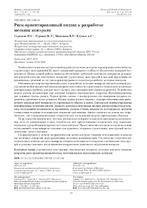| dc.contributor.author | Серенков, П. С. | ru |
| dc.contributor.author | Гуревич, В. Л. | ru |
| dc.contributor.author | Мовламов, В. Р. | ru |
| dc.contributor.author | Етумян, А. С. | ru |
| dc.coverage.spatial | Минск | ru |
| dc.date.accessioned | 2018-06-18T07:15:06Z | |
| dc.date.available | 2018-06-18T07:15:06Z | |
| dc.date.issued | 2018 | |
| dc.identifier.citation | Риск-ориентированный подход к разработке методик контроля = The risk-oriented approach to the development of control method / П. С. Серенков [и др.] // Приборы и методы измерений : научно-технический журнал. - 2018. – Т. 9, № 2. – С. 155-166. | ru |
| dc.identifier.uri | https://rep.bntu.by/handle/data/42018 | |
| dc.description.abstract | Необходимость научно-методической проработки методик контроля характеристик огнестойкости строительных конструкций (СК) имеет наивысший приоритет в области обеспечения пожарной безопасности. Целью данной работы являлось обеспечение требуемой степени достоверности результатов контроля качества огнестойких покрытий строительных конструкций и высокой эффективности принимаемых решений за счет риск-ориентированного подхода к разработке методики контроля. Обоснован риск-ориентированный подход к разработке методики контроля, предполагающий рассмотрение на базе процессной модели контроля огнестойкости строительного объекта всех возможных потенциальных проблем, которые могут вызвать риск некорректного принятия решения. Разработана модель рисков, возникающих при контроле толщины огнезащитного покрытия. Идентифицированы две основные группы рисков. Первая группа связана с неопределенностью измерения толщины покрытия в единичной точке контроля. Вторая группа рисков связана с нерепрезентативностью выборочного контроля всей поверхности строительного объекта в целом. Для каждой группы определены потенциальные источники рисков. Для всего комплекса источников частных рисков приведены результаты исследований механизмов их проявления, оценена степень влияния на достоверность контроля соответствия толщины огнезащитного покрытия требованиям. Анализ проведен на основе как теоретических, так и экспериментальных статистических исследований на ряде строительных объектов. По результатам анализа всех частных рисков недостоверности контроля предложены рациональные пути их минимизации в виде технических или организационно-технических мер, нашедших отражение в разработанном проекте методики контроля. Проект методики контроля построен на основе согласованной схемы контроля толщины огнезащитного покрытия строительных конструкций последовательно тремя сторонами. Сформулирована и решена метрологическая задача контроля толщины огнезащитного покрытия как косвенное измерение неразрушающими методами толщинометрии. Рассмотрены теоретические и прикладные аспекты процесса контроля толщины огнезащитного покрытия строительных конструкций в условиях высокого риска принятия некорректного решения по результатам контроля. | ru |
| dc.language.iso | ru | ru |
| dc.publisher | БНТУ | ru |
| dc.subject | Строительные конструкции | ru |
| dc.subject | Огнезащитное покрытие | ru |
| dc.subject | Методика контроля толщины покрытия | ru |
| dc.subject | Риск-ориентированный подход | ru |
| dc.subject | Источники риска недостоверного контроля | ru |
| dc.subject | Building constructions | en |
| dc.subject | Flame-retardant coating | en |
| dc.subject | Coating thickness control method | en |
| dc.subject | Risk-oriented approach | en |
| dc.subject | Sources of risk of unreliable control | en |
| dc.title | Риск-ориентированный подход к разработке методик контроля | ru |
| dc.title.alternative | The risk-oriented approach to the development of control method | en |
| dc.type | Article | ru |
| dc.identifier.doi | 10.21122/2220-9506-2018-9-2-155-166 | |
| local.description.annotation | The necessity for scientific and methodical study of methods for monitoring the characteristics of flameresistance of building structures has the highest priority in the field of fire safety. The aim of this work was to provide the required degree of reliability of the results of quality control of flame-resistant coatings of building structures and high efficiency of decisions due to the risk-based approach to the development of control methods. Substantiated risk-based approach to the development of methods of control, involving the consideration on the basis of process model, control flame-resistance of building object in all possible potential problems that can cause the risk of incorrect decision-making. A model of the risks arising from the control of the flameretardant coating thickness has been developed. Two major risk groups have been identified. The first group is related to the uncertainty of coating thickness measurement at a single control point. The second group of risks is related to the unrepresentativeness of selective control over the entire surface of the construction object as a whole Potential risk sources have been identified for each group. For the entire range of sources of particular risks the results of studies of the mechanisms of their manifestation, the estimated degree of influence on the accuracy of the control of compliance of flame-retardant coating thickness requirements. The analysis is carried out on the basis of both theoretical and experimental statistical studies on a number of construction projects. According to the results of the analysis of all particular risks of control unreliability, rational ways of their minimization in the form of technical or organizational and technical measures, which are reflected in the developed project of the control method, are proposed. Project control method was built on the basis of a agreed scheme of control of the thickness of the flame-retardant coating of building structures sequentially the three parties. Formulated and solved the task of the metrological control of the thickness of the flame-retardant coating as indirect measurement methods non-destructive thickness measurements. Theoretical and applied aspects of the process of flame-retardant coating thickness control of building structures under conditions of high risk of making incorrect decisions on the results of control are considered. | en |

